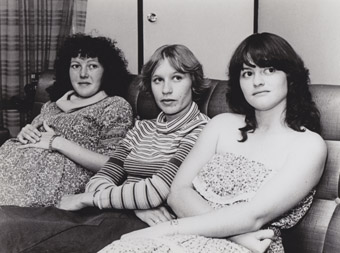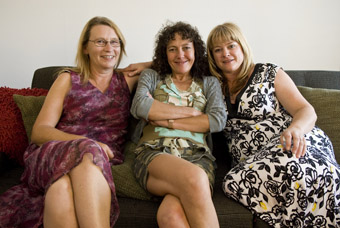confessions & generations
kirsten krauth: gillian armstrong’s love, lust & lies

Diana Doman, Josie Petersen, Kerry Carlson, 1980, Love Lust & Lies
GGILLIAN ARMSTRONG’S MOST RECENT FEATURES, DEATH DEFYING ACTS (2001) AND CHARLOTTE GRAY (2008), HAVE BEEN FIZZERS, FULL OF BIG IDEAS AND CASTS, BUT LACKING THE CAREFUL SCRIPTING AND ATTENTION TO FINE DETAIL THAT MADE HER EARLIER WORKS, HIGH TIDE (1987) AND MY BRILLIANT CAREER (1979), SO MEMORABLE. HER RECENT DOCUMENTARY-MAKING IS ANOTHER STORY.
Unfolding Florence: The Many Lives of Florence Broadhurst (2005) was a wonderful unravelling of the demise of its subject, a luscious experience where style met substance and the audience swooned. Armstrong’s new documentary, Love, Lust & Lies (2009), is more down-to-earth but just as dramatically satisfying, the latest episode in a social-realist experiment that began in 1976 with three 14-year-olds—Kerry, Josie and Diana—plucked from an Adelaide youth centre, to talk to camera about their lives, dreams and hopes (Smokes and Lollies, 1970). Armstrong continued to check in with them at ages 18 (Fourteen’s Good, Eighteen’s Better, 1980 ), 26 (Bingo, Bridesmaids and Braces,1988) and 33 (Not Fourteen Again, 1996). Love, Lust & Lies meets the women in 2009, now at age 47.
In choosing a number of subjects to track through their lives Armstrong took on a challenge similar to Michael Apted in his Up! series, commencing with 7 Up! in 1964. Apart from satisfying your curiosity, seeing how the girls turn out and whether they realise their ambitions—with apparently limited resources—it’s also an opportunity to see how Armstrong reveals herself, how she has matured as a filmmaker. Her willingness to be present within the frame, to answer questions, engage in dialogue about the process, sets her apart from Apted, who remains very much the clinical observer. It’s also made very clear that Australia is not a classless society; her subjects do not have the same opportunities as Armstrong and there’s a sadness for everyone in this realisation.
Kerry and Josie tell Armstrong plainly they don’t want to watch the earlier films, that they “choose to forget,” concentrating on moving forwards. One of the limitations of the series’ format is that Armstrong spends a great deal of time looking backwards over the women’s lives. While good to have a recap, it’s slightly frustrating to spend so much time back then, particularly when I suspect most people seeing the film have seen the others too. I was also curious at first as to why Armstrong spent so much time talking to their daughters rather than the women themselves, as if pushing them out of their own film. But when Josie later says, “You don’t stop parenting when you’ve had your children. Parenting goes on for generations,” I understood the sophistication of Armstrong’s technique. Ultimately the film is not about three women any more; it’s about the legacy of motherhood. Josie and Diana are still struggling with relationships, with children, with deceit—both had absent mothers. Kerry, who had loving parents, knows how to treat her husband (and her own ideas) with care and respect; everything about the interviews reveals a couple in love.

Josie Petersen, Diana Doman, Kerry Carlson, 2009 Love, Lust & Lies
What’s fascinating about this particular instalment is how the stories of children and grandchildren (some now adults) start to reveal the web of lies and intrigue previously woven by the women in earlier episodes. There are dramatic revelations of lies told, not only to Armstrong and her audience, but within the families themselves—lies crucial enough to have destroyed the fabric of their lives. You suspect the women were often lying quite successfully to themselves, too, at the time, and it’s intriguing to reconsider former interviews from this perspective; fresh faces seen in a new light.
The other unavoidable comparison is between 14-year-old girls then and now. While the central themes remain the same—obsession with boys, becoming body-conscious, rebelliousness against parents—there’s no trace here of the contemporary world: mobiles, the internet, email. Back then, after her mother abandons the family, Josie serves her father and brothers food kept warm in the oven, automatically assuming the mother’s role at age 14. The girls are just on the brink—about to negotiate the first wave of feminism—but at this point their options seem so limited: get married; be a secretary; study to teach. As a father says, “A girl can get in a lot of trouble, a boy can’t.” The girls don’t question this. For their daughters, the options are seemingly enormous (the army, being a pilot) but that doesn’t change a great deal in this century—they too end up with limited education, often deadbeat, controlling men around and early pregnancies; the cycle continues.
Apted’s series, now available on DVD, hasn’t quite lived up to expectations, refusing to question its own currency and adapt with the times. Participants suddenly disappeared without notice (I’d spend the whole episode worrying about them: were they dead? just not interested? fed up? in a mental institution?). It was hard to tell what they thought of the process; some appeared to hate it. The interesting questions, never asked, were why did others continue to take part, and what impact did their participation have on the shape of their lives? But one aspect of 7 Up! I did like was the way its three female subjects were often interviewed and framed together. It gave them an interesting dynamic, bouncing off each other in heated debate. I often wished we could spend more time with the women as a group—with Armstrong interrogating them on the trickier issues, to see how they presented in front of each other, what they were willing to reveal, the divergence between narratives alone and together. But you get the feeling they have, as many friends do, drifted apart; they remain polite and tentative, probably not the footage Armstrong was really after.
The film ends, as always, on an open note, but it’s hard to imagine Gillian Armstrong will give up here. You yearn to see the women slogging on, into retirement, hopefully realising their dreams of travel and finding a place of peace. And there’s the burning question that remains: I just have to know, will Diana end up staying with Fury?
Love, Lust & Lies, producer, director Gillian Armstrong, producer Jenny Day, original music Cezary Skubiszewski, cinematographer Paul Costello, editor Nicholas Beauman; screening in limited release nationally.
This article first appeared online May 24
RealTime issue #97 June-July 2010 pg. 20






